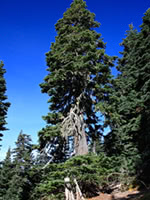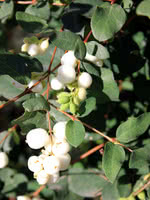Mon-Fri 9am - 5pm Mountain time
Common Snowberry vs Western Red Cedar
Thuja plicata
Symphoricarpos albus
NOT AVAILABLE THIS SEASON - MIGHT RETURN
Western Red Cedar is native to the Pacific Northwest, and is the largest tree in the cypress family. Featuring horizontal branching with scale-like dark green foliage that has a strong aroma. The wood is naturally durable and light, and is resistant to decay and insects, making it sought after for house siding, paneling, furniture, and fences. This is British Columbia's official tree.
Common Snowberry is a small deciduous shrub with characteristic white to pink flowers and clusters of white fruit.
This North American native species is very adaptable, and can be used for erosion control in riparian and restoration areas. Snowberry's fruit attracts wildlife, and livestock can consume the berries without issue.
Western Red Cedar Quick Facts
Common Snowberry Quick Facts
Toxicity: berries toxic to humans

